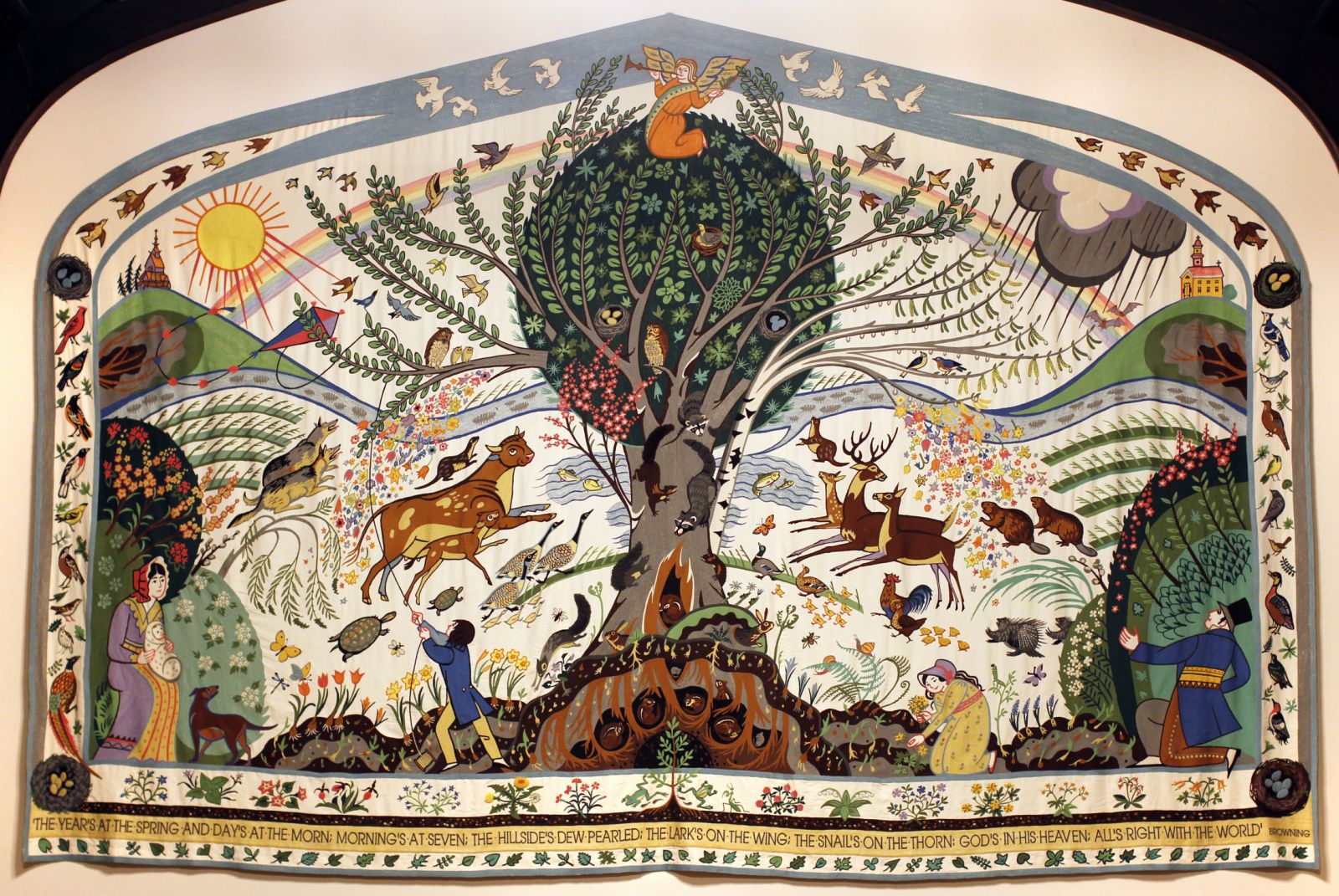Robert Browning & Pauline Baynes
Robert Browning (poem) and Pauline Baynes (tapestry)

Robert Browning: Pippa Passes (excerpt)
The year's at the spring
And day's at the morn;
Morning's at seven;
The hillside's dew-pearled;
The lark's on the wing;
The snail's on the thorn:
God's in His heaven—
All's right with the world!
*****
Excerpt from Pippa Passes by Robert Browning inscribed on a tapestry by Pauline Baynes. This poem appears in the middle of Part I of the play Pippa Passes. The stage direction preceding it is "From without is heard the voice of Pippa singing". The direction immediately following is "Pippa passes." Because of this the poem is found in some anthologies under Pippa Passes or Pippa's Song. The entire play can be found in: Browning, Robert. Pippa Passes and Shorter Poems. Joseph E. Baker, ed. New York: The Odyssey Press, 1947.
Robert Browning (1812-1889) was an English poet and playwright whose mastery of the dramatic monologue made him one of the foremost Victorian poets. His poems are known for their irony, characterization, dark humour, social commentary, historical settings, and challenging vocabulary and syntax. Browning's early career began promisingly, but was not a success. The long poem Pauline brought him to the attention of Dante Gabriel Rossetti, and was followed by Paracelsus, which was praised by Wordsworth and Dickens, but in 1840 the difficult Sordello, which was seen as wilfully obscure, brought his poetry into disrepute. His reputation took more than a decade to recover, during which time he moved away from the Shelleyan forms of his early period and developed a more personal style. In 1846 Browning married the older poet Elizabeth Barrett, who at the time was considerably better known than himself. So started one of history's most famous literary marriages. They went to live in Italy, a country he called "my university", and which features frequently in his work. By the time of her death in 1861, he had published the crucial collection Men and Women. The collection Dramatis Personae and the book-length epic poem The Ring and the Book followed, and made him a leading British poet. He continued to write prolifically, but his reputation today rests largely on the poetry he wrote in this middle period. When Browning died in 1889, he was regarded as a sage and philosopher-poet who through his writing had made contributions to Victorian social and political discourse.
Pauline Baynes (1922-2008) was an English illustrator whose work encompassed more than 100 books, notably several by C. S. Lewis and J. R. R. Tolkien. She was born in Hove, Sussex. For a few years she was raised in India, where her father was commissioner in Agra, but she and her elder sister were sent back to England for their schooling. She spent much of her childhood in Farnham, studying at the Farnham School of Art (now the University for the Creative Arts and eventually attended the Slade School of Fine Art, but after a year there she volunteered to work for the Ministry of Defence, where she made demonstration models for instruction courses. This work did not last long. She was soon transferred to a map-making department, where she acquired skills that she later employed when she drew maps of Narnia for Lewis and of Middle-earth for Tolkien. Baynes is probably best known for her covers and interior illustrations for The Chronicles of Narnia by C. S. Lewis, seven books published, one volume a year, from 1950 to 1956. When she began work on the Narnia books she was already the chosen illustrator of Lewis's friend and colleague J. R. R. Tolkien. Eventually drawings by Baynes appeared not only in Farmer Giles of Ham, but also in The Adventures of Tom Bombadil, Smith of Wootton Major, Tree and Leaf and (after the author's death) the poem Bilbo's Last Song, which appeared as a poster in 1974 and as a book in 1990. Baynes also painted the covers for two British paperback editions of The Lord of the Rings (in one volume in 1973 and in three volumes in 1981) and produced illustrated poster versions of the maps from The Lord of the Rings and The Hobbit as well as the Tolkien-related A Map of Middle-earth.


